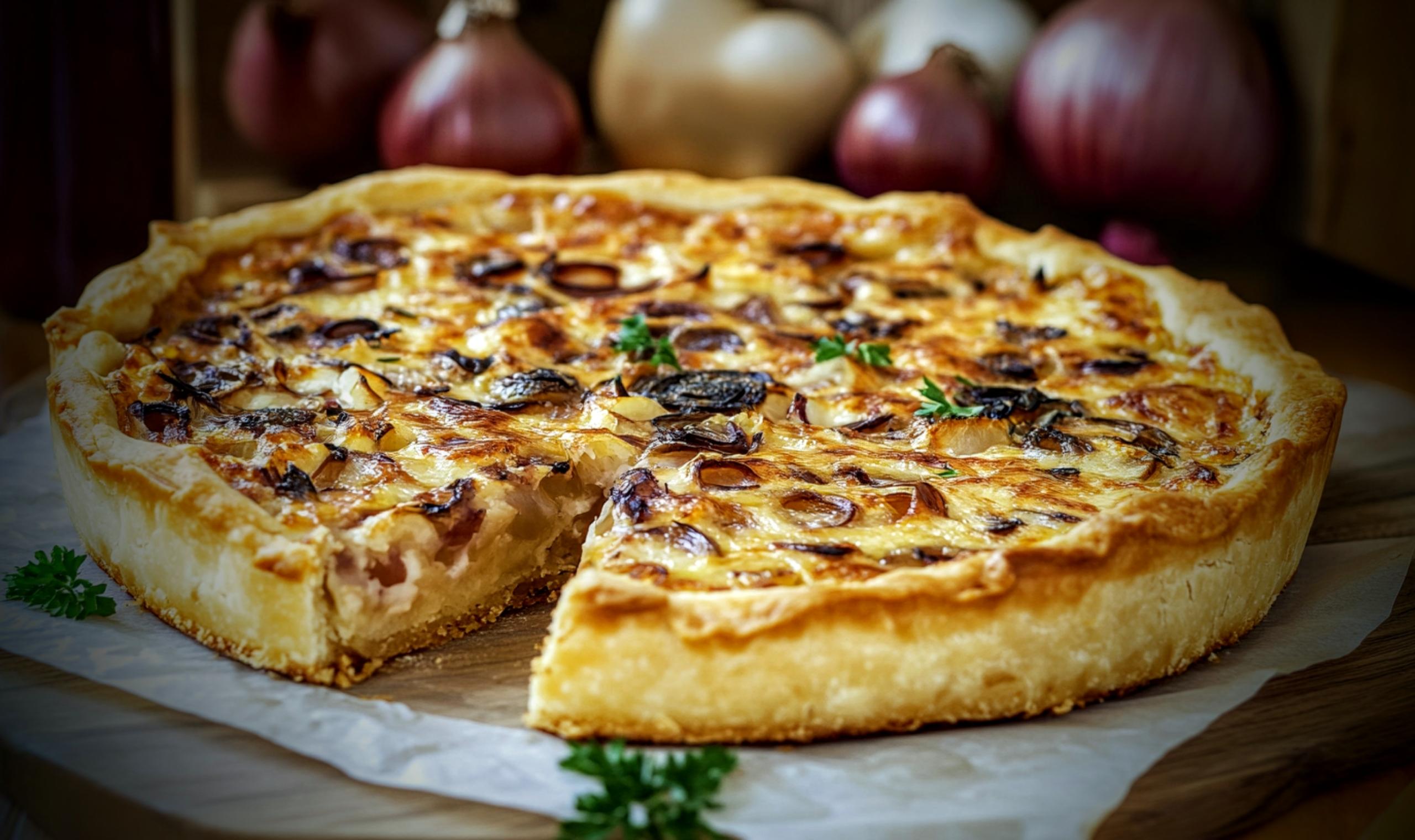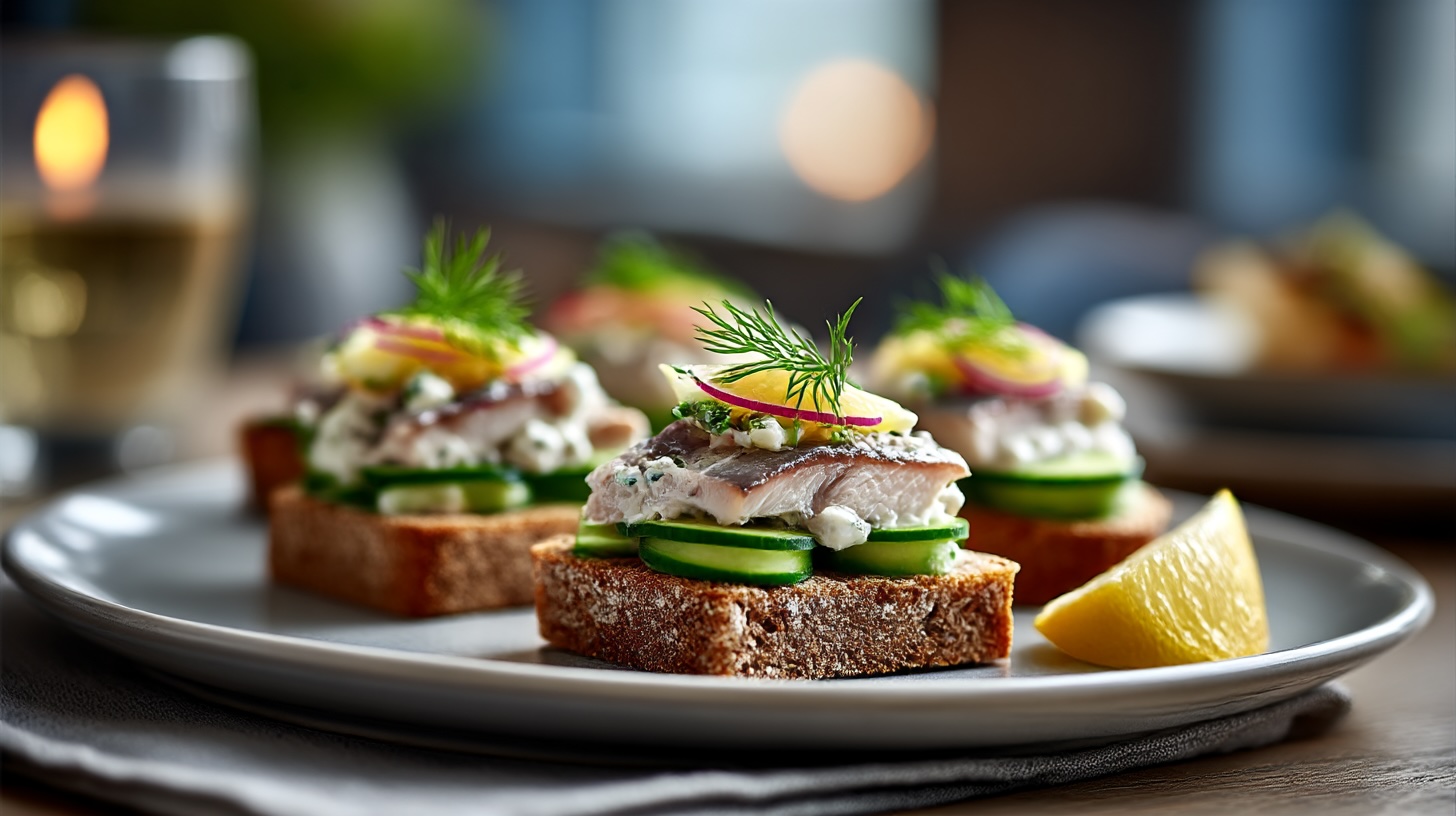Exploring Zwiebelkuchen: German Onion Pie
Zwiebelkuchen, commonly referred to as German onion pie, has deep historical roots embedded within the culinary traditions of Germany. This savoury pie is particularly associated with the regions of Swabia and the Middle Rhine, where it has been a staple for centuries. The origins of zwiebelkuchen can be traced back to the agricultural practices that flourished in these regions, where onions were a key crop cultivated by local farmers. The harvest season, particularly in autumn, often brought about the preparation of this hearty dish, which served as both a meal and a way to celebrate the bounty of the land.
Over the years, zwiebelkuchen has evolved, gaining popularity beyond its regional confines. Initially, this pie was made with simple ingredients, aligning with the peasant cooking style that characterized early German cuisine. Traditionally, the dish consisted of a pastry crust filled with a mixture of onions, cheese, cream, and sometimes bacon, reflecting the agricultural abundance of onions and dairy in the region. The preparation methods of zwiebelkuchen have been passed down through generations, with local variations enriching its cultural significance.
Moreover, the cultural heritage associated with zwiebelkuchen is noteworthy. Festivals and events celebrating German cuisine often feature this onion pie, emphasizing its role as a communal dish that brings people together. In many rural areas, the preparation of zwiebelkuchen is a seasonal ritual that marks the end of the harvest. This illustrates how deeply intertwined the dish is with the agricultural practices of onion cultivation in Germany. As it continues to adapt to modern culinary trends while maintaining its traditional essence, zwiebelkuchen remains a beloved emblem of German gastronomic heritage.
Traditions
Zwiebelkuchen, the traditional German onion pie, is not merely a delicious dish; it is deeply rooted in the cultural practices and customs of Germany. This savory delicacy is especially prominent during the onion harvest season, which typically occurs in late summer to early fall. During this time, communities come together to celebrate the harvest, and zwiebelkuchen takes center stage at various gatherings and family meals, highlighting the importance of seasonal produce in German cuisine.
Across different regions in Germany, varieties of zwiebelkuchen are prepared, each boasting unique flavors that reflect local ingredients and culinary traditions. For instance, in the regions of Württemberg and Baden, zwiebelkuchen is often served with a glass of freshly pressed cider, creating a delightful pairing that enhances the savory flavors of the pie. Meanwhile, in areas like Franconia, lively festivals are held to commemorate the onion harvest, where vendors showcase their versions of this beloved dish alongside other regional specialties. These events not only celebrate the harvest but also foster community relationships, bringing together families, friends, and neighbors to enjoy food, music, and merriment.
Furthermore, zwiebelkuchen has transcended its rustic origins to become a staple in local gastronomy, appreciated by Germans and visitors alike. It symbolizes comfort and tradition, with recipes often passed down through generations. Many families have their own variation of zwiebelkuchen, infused with personal touches that pay homage to culinary heritage. This adaptability showcases the versatility of this dish and its ability to unite people around the dining table, regardless of location or modern influences.
As the popularity of zwiebelkuchen continues to grow, so do the opportunities to experience its rich cultural significance. It stands as a testament to German culinary traditions and an inviting reflection of the community spirit surrounding this cherished pie.
Ingredients: What Makes Zwiebelkuchen Special
Zwiebelkuchen, or German onion pie, is a cherished dish known for its remarkable blend of ingredients that come together to create a savory experience. Central to the pie’s character are the sautéed onions, which dominate the flavor profile. Ideally, yellow or sweet onions, when cooked until they reach a caramelized state, develop a natural sweetness that balances the savory elements of the dish. Their tender texture and rich flavor add depth to the pie, making them an indispensable component.
Bacon or speck brings an additional layer of flavor, contributing a smoky and salty essence that complements the onions beautifully. This meat not only enhances the taste but also adds a delightful crunch to the otherwise soft filling, creating a more complex mouthfeel. For those who prefer a vegetarian option, alternatives such as mushrooms or even smoked tofu can be utilized to mimic the flavors traditionally brought by bacon.
The creamy filling in zwiebelkuchen typically consists of a mixture of sour cream, eggs, and various seasonings. This creamy base binds the onions and bacon together while providing a luscious texture that contrasts with the crust. Many recipes incorporate different herbs—such as thyme or parsley—offering additional aromatic qualities that elevate the dish’s overall taste. The crust itself is often a simple yeast dough or a shortcrust pastry, which adds a comforting crunch and serves as the perfect vessel for the rich filling.
There are many variations of German onion pie across regions, each showcasing unique ingredients and methods. Some may incorporate cheese, while others vary the spices used. Regardless of the adaptation, the fundamental elements of onions, bacon, and creamy filling remain central to creating a delicious zwiebelkuchen that highlights the delightful contrasts in flavor and texture. This beloved dish exemplifies the heartiness of German cuisine, making it a favorite for any occasion.
The Art of Making Zwiebelkuchen
To create a delightful zwiebelkuchen, or German onion pie, one must begin with a thoughtful preparation of both the dough and filling. The first step involves making the dough. Start by combining flour, salt, yeast, and lukewarm water in a large mixing bowl. Knead the mixture for about 10 minutes until it becomes smooth and elastic. Once kneaded, cover the bowl with a damp cloth and allow it to rise in a warm place for approximately one hour. This resting period is essential as it develops the dough’s texture and flavor.
While the dough is rising, focus on preparing the filling. Thinly slice several medium onions and sauté them in a pan with a bit of butter until they become translucent. This process caramelizes the onions and enhances their natural sweetness, a crucial aspect of a well-made zwiebelkuchen. After the onions are cooked, let them cool before mixing them with eggs, sour cream, and seasoning. The combination should yield a creamy, flavorful filling that complements the soft, golden crust.
Once the dough has risen and is ready, roll it out on a floured surface to fit your baking pan. The dough should be thin but sturdy enough to hold the filling. After placing the rolled dough into the pan, pour in the onion mixture evenly, ensuring every slice is covered. As for baking, preheat your oven to 375°F (190°C) and bake the zwiebelkuchen for approximately 30-40 minutes, or until the top is golden brown and slightly crispy. To achieve an even bake, rotate the pie halfway through the baking time.
For those wishing to elevate their zwiebelkuchen, consider adding ingredients such as bacon or herbs, which can introduce additional flavors. Whether you opt for traditional methods or incorporate modern twists, mastering the art of making zwiebelkuchen can provide an enjoyable culinary experience that celebrates this German classic.
Zwiebelkuchen in German Literature and Humor
Zwiebelkuchen, often referred to as the German onion pie, has a notable presence in various spheres of German literature and humor. The pie’s origins and its preparation are woven into the fabric of German culinary culture, making it a subject of fascination and inspiration for many writers. In folklore, Zwiebelkuchen has been depicted as a comforting dish, traditionally served during the harvest season, bringing families together to celebrate the bounty of autumn. This connection to community and tradition has made the dish a symbol of regional pride and nostalgia within German narratives.
Famed German authors have acknowledged Zwiebelkuchen in their works, often highlighting the simplicity yet profound satisfaction derived from enjoying a slice of this savory treat. For instance, in contemporary German literature, characters might reminisce about their childhood experiences of sharing Zwiebelkuchen at local celebrations. These depictions not only underscore the culinary significance of the pie but also reflect broader themes of home, heritage, and the joy of shared meals.
Moreover, Zwiebelkuchen finds its way into German humor, particularly in anecdotes and jokes. Comedians often leverage the pie as a comedic element, using its name or descriptions of its pungent aroma to evoke laughter. One popular joke features an unsuspecting guest experiencing the powerful scent of Zwiebelkuchen at a local festival, only to find themselves overwhelmed yet utterly charmed by its irresistible allure. These humorous references serve to elevate Zwiebelkuchen beyond its role as a simple dish, embedding it deeply into the cultural consciousness of Germany.
As both a literary reference and a humorous motif, Zwiebelkuchen stands as an enduring testament to the dish’s impact on German life, capturing the essence of shared culinary experiences and the laughter that often accompanies them.
Popular Variations and Recipes
Zwiebelkuchen, or German onion pie, is a dish that has inspired numerous adaptations, reflecting regional preferences and dietary requirements. One popular variation is the vegetarian zwiebelkuchen, which substitutes traditional meats, such as bacon or ham, with flavorful vegetables. Ingredients like mushrooms, spinach, or bell peppers can enhance the taste while ensuring the dish remains hearty and satisfying. These additions not only cater to those seeking meatless options but also enrich the overall flavor of this delectable pie.
Another exciting adaptation of the classic zwiebelkuchen involves the use of different types of cheese. While many traditional recipes often include a creamy quark or a tangy sour cream, modern interpretations may feature a combination of cheeses such as feta, goat cheese, or even sharp cheddar. Each cheese brings its unique texture and flavor profile, which can significantly alter the taste experience, allowing for creativity in the kitchen while keeping true to the essence of the German onion pie.
Regional variations further highlight the versatility of zwiebelkuchen. For instance, in the Swabian region, the pie may be made with the addition of caraway seeds, which lend an intriguing aroma and flavor. Meanwhile, those from the Rhine region often mention the use of cider as an ingredient, infusing the dish with a distinct fruity note. Such regional twists demonstrate how communities adapt the essential recipe, making their versions of zwiebelkuchen unique and inviting.
Experimenting with these variations opens a door to countless culinary delights. From vegetarian modifications to cheese options and regional flavors, the endless adaptations of this traditional German onion pie ensure that there is a recipe to suit every palate and occasion.
Where to Find Authentic Zwiebelkuchen
Finding authentic zwiebelkuchen, or German onion pie, can be an enjoyable culinary adventure, especially for those traveling across Germany and other regions with German influence. This savory dish is often a staple during the fall harvest season and can be found in various places. To truly appreciate this comforting pie, exploring local restaurants, bakeries, and food festivals is essential.
One of the best places to start your search is in Germany’s wine-producing regions, particularly in areas like the Pfalz or the Mosel valley. Many local wineries offer seasonal menus featuring zwiebelkuchen as a perfect pairing with their wines. One highly recommended venue is Weinhaus Michel in the Pfalz region, where the family-run establishment serves a delightful rendition of this classic dish, frequently freshly baked and rich in flavor.
In addition to restaurants, local bakeries often craft outstanding versions of zwiebelkuchen, with each baker often putting their unique twist on the ingredients. For instance, in the city of Stuttgart, Bäckerei Ditsch is known for its deliciously flaky versions, drawing locals and tourists alike. Travelers can also seek out regional festivals, such as the Zwiebelkuchenfest in the town of Eppelborn, which celebrates onion pie every autumn. These festivals not only offer a plethora of zwiebelkuchen options but also provide an opportunity to engage with local culture through music and crafts.
When traveling, keep an eye out for traditional German restaurants featuring seasonal dishes on their menus. The best approach is to ask locals for recommendations or look for establishments that highlight regional cuisine. Whether sampling it at a quaint village bakery or sampling different varieties at a food festival, the search for authentic zwiebelkuchen can lead to delightful discoveries of Germany’s culinary heritage.
Pairing Drinks with Zwiebelkuchen
When it comes to enjoying zwiebelkuchen, also known as German onion pie, selecting the right beverage can greatly enhance the overall dining experience. The rich, savory flavors of this pie, which typically features a filling of onions, bacon, and creamy cheese, deserve thoughtful drink pairings to create a harmonious meal.
Traditionally, a light, crisp white wine complements the savory notes of zwiebelkuchen exceptionally well. A classic selection is Riesling, particularly those that are dry or off-dry, providing a refreshing contrast to the pie’s richness. The acidity of Riesling helps to cut through the creamy texture, making each bite more enjoyable. Alternatively, a Silvaner or Gewürztraminer can also harmonize beautifully with the onion flavors while adding a hint of fruity complexity to the palate.
Beer enthusiasts may opt for a traditional German lager or Pilsner, which offers a clean finish that pairs nicely with the savory ingredients. The lightness of these beers will balance the hearty nature of zwiebelkuchen without overwhelming its flavors. For those seeking a more robust option, a Märzen beer can provide the caramel notes that accentuate the sweetness of the caramelized onions.
On the other hand, for a lighter, more refreshing pairing, apple cider is an excellent choice. This fizzy drink adds a touch of sweetness and tartness, making it an ideal counterpart to the savory pie. Whether you choose a still or sparkling version, this beverage can elevate the dining experience while also appealing to a broader audience.
In conclusion, pairing drinks with zwiebelkuchen involves exploring wines, beers, and alternative beverages that complement its robust flavors. The right selection can truly enhance your enjoyment of this beloved German dish, making your meal a memorable one.
The Global Influence of Zwiebelkuchen
Zwiebelkuchen, also known as German onion pie, has not only established itself as a cherished dish in German cuisine but has also garnered attention and admiration internationally. This savory pie, traditionally made with a rich and flaky crust that is filled with onions, cream, and various spices, is a testament to the universal appeal of simple yet flavorful ingredients. As it traveled beyond Germany’s borders, it began to inspire a multitude of adaptations in various culinary traditions.
For example, in France, the concept of onion pie has evolved into the famous “tarte à l’oignon.” This dish showcases a similar combination of caramelized onions and creamy filling, often seasoned with herbs, which resonates with the essence of zwiebelkuchen. Likewise, regions of Eastern Europe, particularly in Hungary, have their own variations that introduce different spices and ingredients, reflecting local tastes. In these adaptations, one can observe how global cuisine draws inspiration from the familiar, intertwining traditional practices with innovative twists.
Another notable adaptation can be found in the United States, where the idea of twisting the traditional zwiebelkuchen into a more modern context has emerged. Some American bakers and chefs incorporate different cheeses or even vegetables, creating unique renditions while still honoring the original flavors. The increasing popularity of savory pies in restaurants and culinary competitions has further contributed to the revival of interest in dishes like zwiebelkuchen, showcasing its versatility.
Worldwide, food enthusiasts have embraced this flavorful dish, leading to cookbooks, online recipes, and culinary courses dedicated to exploring the essence of German onion pie. As zwiebelkuchen continues to transcend cultural boundaries, it remains a culinary symbol of shared appreciation for hearty, comforting food that can be enjoyed by diverse communities across the globe. The influence of zwiebelkuchen is evident as it evolves through various interpretations and adaptations, proving that good food indeed knows no borders.



